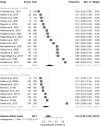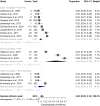Prevalence and Antibiotic Resistance in Campylobacter spp. Isolated from Humans and Food-Producing Animals in West Africa: A Systematic Review and Meta-Analysis
- PMID: 35215086
- PMCID: PMC8877155
- DOI: 10.3390/pathogens11020140
Prevalence and Antibiotic Resistance in Campylobacter spp. Isolated from Humans and Food-Producing Animals in West Africa: A Systematic Review and Meta-Analysis
Abstract
Campylobacter species are one of the leading causes of gastroenteritis in humans. This review reports on the prevalence and antibiotic resistance data of Campylobacter spp. isolated from humans and food-producing animals in West Africa. A systematic search was carried out in five databases for original articles published between January 2000 and July 2021. Among 791 studies found, 38 original articles from seven (41%) out of the 17 countries in West Africa met the inclusion criteria. For studies conducted in food-producing animals, the overall pooled prevalence of Campylobacter spp. was 34% (95% CI: 25-45). The MDR prevalence was 59% (95% CI: 29-84) and half (50%, 13/26) of the animal studies had samples collected from the market. The human studies recorded a lower pooled prevalence of Campylobacter spp. (10%, 95% CI: 6-17), but a considerably higher rate of MDR prevalence (91%; 95% CI: 67-98). The majority (85%, 11/13) of the human studies took place in a hospital. Campylobacter jejuni and Campylobacter coli were the most common species isolated from both animals and humans. Our findings suggest that Campylobacter spp. is highly prevalent in West Africa. Therefore, improved farm hygiene and 'One Health' surveillance systems are needed to reduce transmission.
Keywords: Campylobacter; West Africa; antibiotic resistance; campylobacteriosis; food-producing animals; pooled prevalence.
Conflict of interest statement
The authors declare no conflict of interest.
Figures







References
-
- Molina-Flores B., Manzano-Baena P., Coulibaly M.D. The Role of Livestock in Food Security, Poverty Reduction and Wealth Creation in West Africa. FAO; Rome, Italy: 2020.
-
- Ngure F., Gelli A., Becquey E., Ganaba R., Headey D., Huybregts L., Pedehombga A., Sanou A., Traore A., Zongo F., et al. Exposure to Livestock Feces and Water Quality, Sanitation, and Hygiene (WASH) Conditions among Caregivers and Young Children: Formative Research in Rural Burkina Faso. Am. J. Trop. Med. Hyg. 2019;100:998–1004. doi: 10.4269/ajtmh.18-0333. - DOI - PMC - PubMed
-
- Salihu M.D., Junaidu A.U., Magaji A.A., Abubakar M.B., Adamu A.Y., Yakubu A.S. Prevalence of Campylobacter in Poultry Meat in Sokoto, North-Western Nigeria. J. Public Health Epidemiol. 2009;1:41–45.
Publication types
Grants and funding
LinkOut - more resources
Full Text Sources
Miscellaneous

